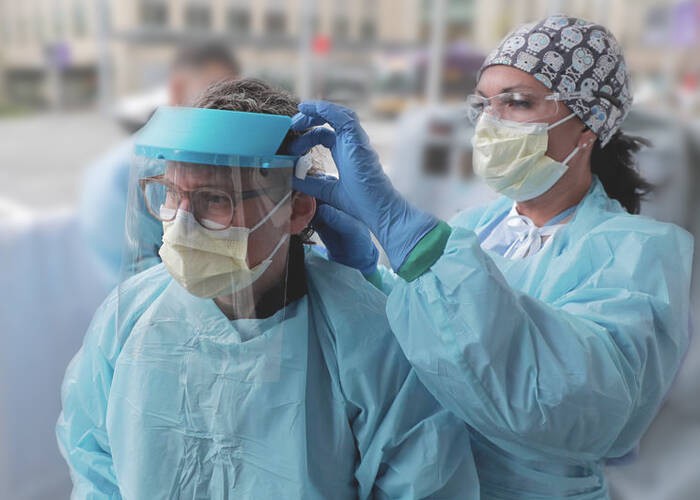
It has become common knowledge that maks such as KN95s, 3-ply masks, and even cotton masks are extremely effective, while gaiters and homemade coverings have been shown to actually worsen the spread. However, in addition to masks, face shields and eye protection can be a very good method of protecting yourself and others from COVID-19.
Face Shields
Face shields are a commonly discussed topic as a form of facial protection. If you are considering investing in one or would like to know more about it, here is a short summary of recent studies and findings that may help you decide if it is an optimal choice for you.
Face coverings, in general, have proven to be incredibly efficient at preventing the spread of infection in addition to social distancing. The most common way people have been doing this is through some sort of mask. Some people may encounter some issues with wearing masks or are in the medical field in which transmission and exposure is much higher, in which case a face shield is likely appealing. The following is a list of advantages and disadvantages of using a face shield as a form of protection.
Pros
- People with difficulty breathing may find it easier to breathe in a shield than in a mask
- People with difficulty hearing or use sign language may find it easier to communicate with shields instead of masks
- It prevents the spread and contraction of the disease
- It may be easier to avoid touching the face with shields instead of face masks which people are more likely to touch and adjust. Touching the face may increase the possibility of contracting the virus through various mucous membranes, including the eyes, which have shown to be a possible form of entry for many viruses, including SARS-CoV-2
Cons
- It is not a full protective measure given how it likely spreads
- Some studies show that face masks are still more effective in limiting the transmission of the virus especially given the recent findings that the virus is an aerosol and can travel in air
- It is mostly used in addition to face masks in health care settings
Certain settings or populations, including those stated, may benefit from using a face shield. For example, people in places of closed and confined spaces may use it as an added protective measure. However, it is by no means a substitute for well-established forms of protection, such as face masks or social distancing. If face shields truly benefit you and are considering investing in one, or maybe you are sticking to your masks, make sure to regularly keep your face coverings, shield or mask, in good condition by regularly sanitizing it and checking it for any damage. If used appropriately along with social distancing guidelines, face shields may be a favorable option for many, just as face masks are just enough for others.
Eye protection
There are not as many sources that emphasize the transmission of the virus through the mucous membranes of the eyes. However, some have encouraged the use of eye protection to prevent contracting the virus. First, before deciding on whether to invest in eye protective gear, there are certain pieces of information that should be addressed. The reason for lack of discussion around eye protection compared to masks and social distancing is likely because the virus, SARS-CoV-2, is a recently discovered aerosol and likes to travel through the air. This is why masks and social distancing have been key factors in preventing the spread and contraction of the disease. However, eye protection came to attention after considering the possibility that it can also be contracted through the mucous membranes of the eye, also known as conjunctiva. According to the CDC, it is possible for other viruses to spread this way through contact with contaminated surfaces, such as hands, or even through respiratory droplets from coughs or sneezes. According to an observational study on different modes of protection to prevent person-to-person transmission, the use of eye protection was correlated with a reduced risk of contraction. However, it does not provide clear evidence that COVID-19 can be contracted, at a concerning rate, through the eyes. Likely reasons for contraction may include touching the face often or other forms of contamination.
Given the abstract information that we have now, it is true that the use of eye protection as a supplement to social distancing measures and appropriate use of face coverings may be incredibly beneficial and effective in preventing the contraction and spread of the virus. At this time with the information we have at the moment, whether to invest in a form of eye protective gear, something that covers and protects the eyes entirely–unlike a pair of glasses, is entirely optional. However, it is important to keep in mind that even with the use of eye protection, it cannot substitute for facial protection and social distancing, both of which have been scientifically proven to significantly reduce the risk of infection. If you decide against investing in eye protection, at least for now, the CDC recommends to avoid touching your face and eyes in addition to following its other guidelines.
Resources
https://www.thelancet.com/journals/lancet/article/PIIS0140-6736(20)31142-9/fulltext
https://www.aarp.org/health/healthy-living/info-2020/shields-compared-to-masks.html
https://health.clevelandclinic.org/will-a-face-shield-protect-you-from-the-coronavirus/
https://www.cdc.gov/niosh/topics/eye/eye-infectious.html
By Emin Lee
